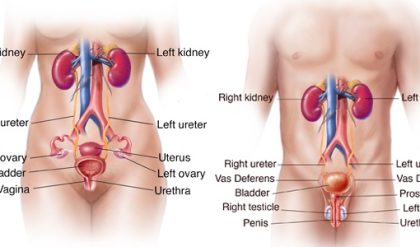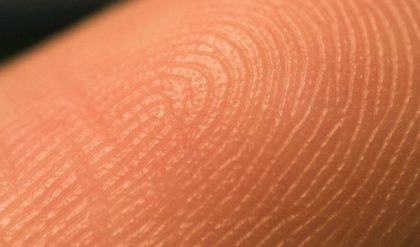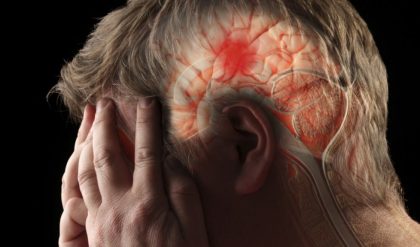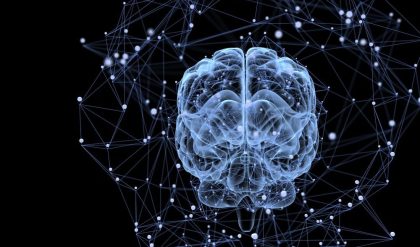Deep within the cerebral hemispheres, large gray masses of nerve cells, called nuclei, form components of the basal ganglia. Four basal ganglia can be distinguished: (1) the caudate nucleus, (2) the putamen, (3) the globus pallidus, and (4) the amygdala. Phylogenetically, the amygdala is the oldest of the basal ganglia and is often referred to as the archistriatum; the globus pallidus is known as the paleostriatum, and the caudate nucleus and putamen are together known as the neostriatum, or simply striatum. Together, the putamen and the adjacent globus pallidus are referred to as the lentiform nucleus, while the caudate nucleus, putamen, and globus pallidus form the corpus striatum.
The caudate nucleus and the putamen are continuous rostrally and ventrally, and they have similar cellular compositions, cytochemical features, and functions but slightly different connections. The putamen lies deep within the cortex of the insular lobe, while the caudate nucleus has a C-shaped configuration that parallels the lateral ventricle. The head of the caudate nucleus protrudes into the anterior horn of the lateral ventricle, the body lies above and lateral to the thalamus, and the tail is in the roof of the inferior horn of the lateral ventricle. The tail of the caudate nucleus ends in relationship to the amygdaloid nuclear complex, which lies in the temporal lobe beneath the cortex of the uncus.
There are an enormous number of neurons within the caudate nucleus and putamen; they are of two basic types: spiny and aspiny. Spiny striatal neurons are medium-size cells with radiating dendrites that are studded with spines. Axons of these cells project beyond the boundaries of the caudate nucleus and putamen. All nerves providing input to the caudate nucleus and the putamen terminate upon the dendritic spines of spiny striatal neurons, and all output is via axons of the same neurons. Chemically, spiny striatal neurons are heterogeneous; that is, most contain more than one neurotransmitter. Gamma-aminobutyric acid (GABA) is the primary neurotransmitter contained in spiny striatal neurons. Other neurotransmitters found in spiny striatal neurons include substance P and enkephalin.
Aspiny striatal neurons have smooth dendrites and short axons confined to the caudate nucleus or putamen. Small aspiny striatal neurons secrete GABA, neuropeptide Y, somatostatin, or some combination of these. The largest aspiny neurons are evenly distributed neurons that also secrete neurotransmitters and are important in maintaining the balance of dopamine and GABA.
Because the caudate nucleus and putamen receive varied and diverse inputs from multiple sources that utilize different neurotransmitters, they are regarded as the receptive component of the corpus striatum. Most input originates from regions of the cerebral cortex, with the connecting corticostriate fibres containing the excitatory neurotransmitter glutamate. In addition, afferent fibres originating from a large nucleus located in the midbrain called the substantia nigra or from intralaminar thalamic nuclei project to the caudate nucleus or the putamen. Neurons in the substantia nigra are known to synthesize dopamine, but the neurotransmitter secreted by thalamostriate neurons has not been identified. All striatal afferent systems terminate in patchy areas called strisomes; areas not receiving terminals are called the matrix. Spiny striatal neurons containing GABA, substance P, and enkephalin project in a specific pattern onto the globus pallidus and the substantia nigra.
The globus pallidus, consisting of two cytologically similar wedge-shaped segments, the lateral and the medial, lies between the putamen and the internal capsule. Striatopallidal fibres from the caudate nucleus and putamen converge on the globus pallidus like spokes of a wheel. Both segments of the pallidum receive GABAergic terminals, but in addition the medial segment receives substance P fibres, and the lateral segment receives enkephalinergic projections. The output of the entire corpus striatum (i.e., the caudate nucleus, putamen, and globus pallidus together) arises from GABAergic cells in the medial pallidal segment and in the substantia nigra, both of which receive fibres from the striatum. GABAergic cells in the medial pallidal segment and the substantia nigra project to different nuclei in the thalamus; these in turn influence distinct regions of the cerebral cortex involved with motor function. The lateral segment of the globus pallidus, on the other hand, projects almost exclusively to the subthalamic nucleus, from which it receives reciprocal input. No part of the corpus striatum projects fibres to spinal levels.
Pathological processes involving the corpus striatum and related nuclei are associated with a variety of specific diseases characterized by abnormal involuntary movements (collectively referred to as dyskinesia) and significant alterations of muscle tone. Parkinson disease and Huntington disease are among the more prevalent syndromes; each appears related to deficiencies in the synthesis of particular neurotransmitters.
The amygdala, located ventral to the corpus striatum in medial parts of the temporal lobe, is an almond-shaped nucleus underlying the uncus. Although it receives olfactory inputs, the amygdala plays no role in olfactory perception. This nucleus also has reciprocal connections with the hypothalamus, the basal forebrain, and regions of the cerebral cortex. It plays important roles in visceral, endocrine, and cognitive functions related to motivational behaviour.




